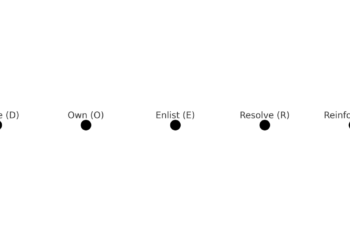When you think about leadership development, what comes to mind?
- Mentoring and coaching?
- Getting feedback from colleagues?
- Learning on the job?
- Taking on stretch assignments?
- Refining decision-making under pressure?
All of these are valuable, but they aren’t always enough.
Processing, conceptualizing, and discussing leadership are certainly useful, and on-the-job learning brings leadership development to life. But sometimes, the fastest way to grow as a leader is through “offsite” practice.
The question is: How do you simulate leadership experiences in ways that truly promote and accelerate the right kind of growth, growth that strengthens leadership skills in a way that translates to real-world effectiveness?
The Key to Effective Leadership Practice
For leadership practice to be effective, it must feel real.
Leaders must:
- Engage with meaningful challenges
- Make decisions under pressure
- Receive honest, constructive feedback
But too often, leadership experiences are shaped by external factors:
- Hierarchies that dictate who speaks and who listens
- Reputations that influence whose ideas are valued
- Unconscious biases that affect feedback and opportunity
These distortions limit real growth.
The question, then, is how to create practice environments that provide the full intensity of real leadership challenges, without these constraints.
Why Structured Leadership Practice is So Powerful
That’s why structured leadership practice is so powerful: it allows leaders to develop their skills in ways that push them toward intentional growth, in the right ways, and ideally while also actively solving problems.
And just as in any other form of skill-building, the conditions of practice matter.
Anonymity: An Overlooked Leadership Development Tool
One of the most useful alternatives to traditional leadership practice environments is anonymity.
By removing names, titles, and personal details from the equation, leaders engage in pure leadership practice, focused entirely on:
- The challenge at hand
- Their leadership behaviors
- The effectiveness of their decisions
This kind of anonymous leadership experience functions like a bridge between practice and real-world performance, a space where leaders can test their abilities, refine their approach, and grow faster.
How Bias Impacts Leadership Growth
Bias creeps into every part of leadership development. It affects:
- Who gets stretch assignments (who is trusted with real challenges)
- Who is encouraged (or overlooked) for training (who is given opportunities to develop)
- How feedback is delivered (whether someone gets direct, constructive input or vague, sugarcoated guidance)
But leadership growth doesn’t happen in a vacuum; it depends on real experiences and high-quality feedback.
For leaders to develop, they need:
- Learning by doing (gaining firsthand experience in decision-making and problem-solving)
- Receiving coaching (getting guidance and input to refine their skills)
- Reflecting on performance (understanding what worked, what didn’t, and how to improve)
When bias enters the picture, it distorts this entire process.
- A leader shielded from challenges doesn’t gain experience.
- A leader excluded from training doesn’t develop critical skills.
- A leader who receives filtered or overly cautious feedback doesn’t see where they need to improve.
Real-World Examples of Leadership Bias
- A young manager might be seen as “not experienced enough” and given only gentle feedback, robbing them of honest insights to grow.
- A seasoned-looking leader might have their ideas favored or their missteps overlooked because people assume they have experience.
Two people with equal potential can have vastly different development paths because of these assumptions.
- If bias shields someone from critique or keeps them from real challenges, their growth stalls.
- If bias causes someone to be judged too harshly or excluded, they never get to prove their capabilities.
This is why anonymity isn’t just a novelty, it’s a tool. It removes these barriers, creating an environment where leaders can practice leadership in its purest form.
Leading Without Labels: The Leader Bridge Approach
We use the term leader bridge to describe a structured way for leaders to practice, be challenged, and grow, while also solving real problems.
How It Works
- Participants take on leadership challenges anonymously.
- No names, job titles, or personal details are shared.
- Leaders are matched based on the leadership challenge they want to tackle, not their job level or industry.
Instead of being judged by who you are, you’re judged by how you lead.
For example:
- If your challenge is improving team communication, you might work with someone from a different organization who is also trying to improve communication.
- If you’re working on resolving team conflict, you’ll collaborate with another leader facing a similar challenge.
What you have in common is the problem, not your position or background.
In most leadership settings, your reputation precedes you.
But in a leader bridge, your reputation is built in the moment.
You earn credibility based on how you listen, strategize, and guide discussions, not based on your title.
This makes the leader bridge an essential practice ground for leadership, where leaders can:
- Test their skills
- Refine their approach
- Receive honest, immediate feedback
Why Anonymity Transforms Leadership Growth
1. Focus on Behavior, Not Background
First impressions aren’t based on resumes, titles, or years of experience, only actions.
- A junior leader’s ideas won’t be dismissed just because they’re young.
- A senior leader won’t get an automatic pass just because they’re experienced.
- Your leadership stands on its own.
2. Challenge-Centered Pairing
- Participants are matched by leadership challenge, not by department or seniority.
- You or your partner present a leadership struggle and focus on solutions.
- Discussions stay practical and problem-solving-oriented, not sidetracked by personal details.
3. Unfiltered, Actionable Feedback
- Feedback is based only on what was observed during the session.
- If you facilitated well, your partner will point that out. And likewise, you will provide feedback to your partner on how well they facilitated/collaborated.
- This is a shared experience, with success depending on both of you.
Expect candid, specific feedback like:
- “You kept us focused when we got stuck.”
- “You didn’t invite input after presenting your idea, and I felt my perspective was missing.”
This helps you quickly identify what to keep doing and what to adjust.
4. A Safe Space to Experiment
- Anonymity creates a safety net for risk-taking.
- You can step outside your comfort zone without fear of failure harming your professional reputation.
- You can test new approaches or admit what you don’t know without judgment.
This frees leaders to be bold and honest, which drives genuine growth.
Final Thought
By stripping away bias and distractions, a leader bridge creates a pure leadership development experience:
Leadership actions → Immediate feedback → Rapid improvement
More importantly, this approach is part of a larger system of leadership development, one that is built on:
- Structured practice
- Real-world challenges
- High-quality feedback
A leader bridge is just one element of this larger offering, helping leaders refine their skills in a focused and unbiased environment before bringing those skills back to their teams and organizations.
Would anonymity accelerate your leadership growth?


































